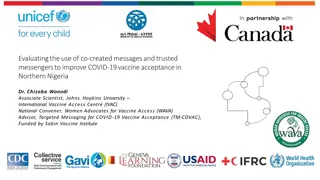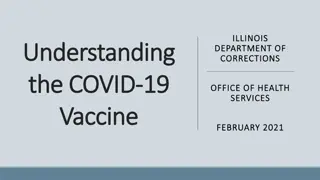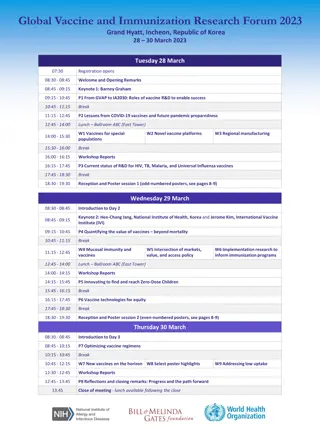National COVID-19 Vaccine Deployment and Roll-Out Plan in Zimbabwe
The Republic of Zimbabwe is gearing up for the introduction of a COVID-19 vaccine as part of its response to the pandemic, with a focus on deploying 200,000 doses to priority groups. The comprehensive plan includes key strategies, financing alignment, and integration into national governance mechanisms. Objectives of the plan emphasize high-quality vaccination services, achieving herd immunity, and monitoring progress effectively. The regulatory framework ensures the emergency use of the vaccine under the authority of the Medicines Control Authority of Zimbabwe (MCAZ).
Download Presentation

Please find below an Image/Link to download the presentation.
The content on the website is provided AS IS for your information and personal use only. It may not be sold, licensed, or shared on other websites without obtaining consent from the author.If you encounter any issues during the download, it is possible that the publisher has removed the file from their server.
You are allowed to download the files provided on this website for personal or commercial use, subject to the condition that they are used lawfully. All files are the property of their respective owners.
The content on the website is provided AS IS for your information and personal use only. It may not be sold, licensed, or shared on other websites without obtaining consent from the author.
E N D
Presentation Transcript
COVID VACCINE DEPLOYMENT AND ROLL OUT PLAN HON. GEN (RETD) DR. C. G. D. N. CHIWENGA Vice President of the Republic of Zimbabwe and Minister of Health and Child Care
Background The COVID-19 pandemic has affected the country resulting in 34 949 positive cases and 1382 deaths as of 11 February 2021 The high numbers of both positive cases and deaths has prompted the country to plan for the introduction of a vaccine The country has already secured 200 000 doses of the vaccine which will be administered to priority groups country In addition, an operational budget to fund the implementation of planned activities is in place and has been shared with Treasury The country COVID-19 vaccination and deployment plan identifies key areas for successful roll out of the vaccine.
Objectives of the meeting Outline the roll out plan and deployment Plan framework To appraise stakeholders on the country state of readiness for introduction
Objectives of the National Roll out and Deployment Vaccination Plan The National Roll out and Deployment and Vaccination Plan (NDVP)is a guiding document that provides a framework for: Designing strategies for the deployment, implementation and monitoring of the COVID-19 vaccine(s) in the country Ensuring the plan and related financing is well aligned to the Zimbabwe COVID-19 recovery and response and support plans, and that implementation is fully integrated into national governance mechanisms.
OBJECTIVE OF COVID VACCINATION Broad Objective To enable high quality vaccination services and reduce morbidity and mortality due to Covid 19 disease Specific Objectives To vaccinate eligible population on a voluntary basis for free Vaccinate minimum 60% of the total population to achieve herd immunity . To initiate vaccination through eligible high risk target populations To provide adequate vaccines & supplies for the activity To ensure availability of functional cold chain equipment at all levels To monitor progress, AEFIs, and provide corrective action Create demand for immunization
Regulatory Framework The COVID-19 vaccine is an emergency vaccine registered by MCAZ under Emergency use Authority, this is in terms of section 75 of Medicines and Allied Substances Control Act. The Pharmacovigilance and Clinical Trials Committee will implement vaccine vigilance plans to monitor the safety and effectiveness of the COVID-19 vaccine in use. The vaccine consignment shall be physically verified and cleared by MCAZ upon arrival The consignment shall be cleared on the basis of the standard vaccine lot release documentation
Regulatory Framework Ministry will set up and implement the safety monitoring plan to enable swift detection of any Adverse Events Following Immunization (AEFI Ministry to consider a study to confirm immunogenicity of the product in the local population
Planning and coordination Established (or engage an existing committee) a National Coordinating Committee (NCC) for COVID-19 vaccine introduction with terms of reference, roles and responsibilities and regular meetings The Inter- Agency Coordinating Committee (ICC) was tasked to spearhead planning and preparations for COVID-19 vaccination. The National COVID-19 Response Coordinator was coopted into the ICC with the Permanent Secretary being the chair of the committee. Public Partnership initiatives will be oordinated by Ministry of Finance and Development The MoHCC will implement effective deployment of the COVID-19 vaccines through the National EPI program
Resources and funding The total estimated operational budget for COVID-19 vaccination over all phases is USD 6,778,777 The total estimated cost for phase 1 stage 1 is USD1,3 million Budget summary for Phase 1 stage 1 and for all stages is indicated in the tables below
Budget Breakdown for Phase 1 Stage 1 Item Description Amount ( USD) National Planning and Training 2 640 Provincial Planning and Training 45 480 Vaccination 741 577 Supportive Supervision 136 364 Advocacy and Communication 262 240 Logistics Vaccine Supply and cold Chain 14 530 Data Management 27 678 Total 1 202 831 Public Private
Target populations for Vaccinations Population % of Population Phase 1 ( stage 1 and 2) 3 662 279 22% Phase 2 3 050 855 18.4% Phase 3 3 050 855 18.4% Subtotal 9 763 988 58.8% Total population under 16 yrs 6 795 000 41.2% Total Populations 16 558 987 100%
Target Population for Phase 1 Stage 1 Department/Ministry Total Health Workers for Vaccination Ministry of Health 49 000 49 000 Ministry of Heath Private Sector Zimbabwe Defence Forces 30 000 3 000 Zimbabwe Prison Service 50 000 500 Zimbabwe Prisons Service and Correctional Centre 13000 700 ZIMRA Immigration
Target groups for vaccinations Phase 1 - population at high risk Stage 1 Front line Workers (eg Health Workers ,Ports of Entry Personnel ZIMRA, Immigration Customs, Security and others ) Stage 11 VHW ,Chronic Illnesses, Elderly Population 60years, Inmates Prison Population & others in confined settlements including Tongogara refugee camp Phase 2 Lecturers, All School Staff Population and other staff at medium risk depending with the epidemiological picture of the disease Phase 3 Population at low risk
Training Development & adaption of training materials for all activities The Ministry has arranged trainings of trainers (TOTs) for provincial and district trainers. Provincial and district trainers will in turn train health workers at service delivery centers. EPI will support planning and conduct of the TOTs.. Online, in-person and blended learning (combination of online and in-person) are the most common methods which will be used to train staff. Areas of training to include; vaccine storage, communication, surveillance, vaccination and M & E, Management of AEFI &Waste Management
Vaccination (Service Delivery) The actual administration of the vaccine will be done at fixed and outreach points 1-2 outreach teams will be allocated per rural district depending on the size of the district with 5 people per team Harare City will be allocated 11 teams, Bulawayo 4 teams and Chitungwiza 2 teams Vaccination teams will require fuel, lunch and daily subsistence allowances. The assumption is vaccination will be conducted over 10 days in the first round and 5 days in the second round Supervisors drawn from head office, provinces and districts will monitor planning, implementation and outcomes.
Supply Chain Management The immunization supply chain of Zimbabwe consists of four levels which are Central, Provincial, District and service delivery. Vaccine distribution follows this channel from the Central Vaccine to 1O Provincial and 63 district vaccine stores; and then to more than 1,800 service delivery facilities. The Central Vaccine Stores distributes vaccines to Provincial Vaccine Stores Provinces distribute vaccines to district vaccine stores and districts to service delivery as well. Distribution of Covid-19 vaccine will follow the existing distribution structure of routine vaccines and supplies. The vaccine will be received at the airport ,distributed to provinces and districts under police escort
Supply Chain Distribution planning is based on target population per province Ensure adequate supply of potent vaccine to all eligible populations Ensure functional cold chain equipment at all levels There will be police escort accompanying ZEPI distribution vans Distributed to provincial cold rooms with capacity of 9m under police escort Distributed to districts with cold chain capacity of an average 200 litres( 2-3 refrigerators) Logistical support for vaccine distribution & cold chain management throughout the period from planning to implementation Supply fuel for central level & provincial standby generators
Cold chain Capacity Description Level of Service National Description Zhendre WICR Net Capacity 8 10 m3 Average Age 8 8 10 m3 Haier WICR metres 8 8 m3 Walk In Freezer Room 30 8 m3 Provincial Haier WICR 8 8 m3 Zhendre WICR 8 Vestfrost MK304, 105 litres 15 Vestfrost MF314 218 litres* 15 Electrolux CH46OE 442 litres District Dometic TCW3000 AC 150 litres** 9 Dometic TCW2000 AC 126.5 litres** 9 Service Delivery Level SunDanzer BFRV50 54 litres 4 True Energy BLF100 99 litres 6 Sibir V110GE 32 litres 15 Electrolux RCW42 24 litres 20
Information Dissemination ( Advocacy Communication and Social Mobilization) Advocacy meetings and activities to be conducted at all levels National vaccination launch to be conducted virtually to rally all stakeholders for COVID 19 Social Mobilisation done at all levels in order to create demand for the vaccine Community mobilisation for vaccination will be conducted via Radio and TV programs & announcements Interpersonal communication with target groups Newspapers articles and advertisements Social media campaigns; Facebook, Whattsapp, Twitter Bulk SMSes Billboards, banners, posters and body media Crisis Communication addressing serious AEFIs
Vaccine Safety Monitoring and Management of AEFI and Injection Safetya In partnership with MoHCC- ZEPI, the National Pharmacovigilance & Clinical Trials Committee, MCAZ, are the main drivers of vaccine safety surveillance COVID-19 vaccine safety surveillance will be guided by already existing MoHCC s Adverse Events Following Immunization (AEFI) surveillance guidelines and the WHO COVID-19 vaccines safety surveillance manual. Safety surveillance for COVID-19 vaccine will be further strengthened through additional: Training of national stakeholders and investigation teams Training of national AEFI committee on causality assessment of adverse events following COVID-19 vaccination Training and preparation of health care workers on identification, management and reporting of potential cases of anaphylaxis and ensuring availability of comprehensive emergency tray at all vaccination points. The trainings will be provided as part of a comprehensive COVID-19 vaccine introduction trainings. Instituting active surveillance of Adverse Events of Special Interest following COVID- 19 vaccination.
Biohazard and immunization waste management Management of waste related to COVID-19 vaccination requires special attention due to the infectious nature of the virus. Waste generated from Covid-19 vaccination will be according to the country s existing waste management guidelines for treatment of health waste. There will be waste segregation at point of generation following existing protocols. All medical waste will be incinerated either at point of generation if there is a functional incinerator or at some central incineration point in which case transport will provided to move the waste to the incineration point.
MONITORING & EVALUATION Development of an M & E Framework to guide planning & implementation There will be pre vaccination demographic data collection Conduct Preparedness Assessment to assess readiness at all levels Development of data collection tools; i.e. tally sheets, summary sheets, vaccination cards Consolidation and reporting of the number reached will be done on a daily basis using existing platforms and structures Disease surveillance will include AEFI monitoring There will be blood collection to determine antibodies before and after vaccination. Conduct a Post Campaign Coverage Survey to validate administrative data Conduct a Post Introduction Evaluation to assess the quality of the introduction of the COVID-19 vaccine and help inform future introductions
TENTATIVE TIMELINE OF ACTIVITIES ACTIVITY PERIOD PLANNING ONGOING TRAINING 12-16 FEBRUARY PROCUREMENT 08 -15 FEBRUARY VACCINE DISTRIBUTION 15-26 FEBRUARY COLD CHAIN INVENTORY ONGOING ADVOCACY, COMMUNICATION & MOBILISATION FROM 08 FEBRUARY MONITORING & EVALUATION FROM 08 FEBRUARY VACCINATION 18 FEBRUARY























